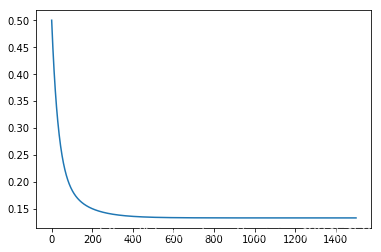吴恩达机器学习练习文件下载地址:
链接:https://pan.baidu.com/s/1RvUeG10FBpV9RyFtOX1Zdw
提取码:5b4x
单变量线性回归
import numpy as np
import matplotlib.pyplot as plt
path = 'E:\吴恩达\作业代码资料\全部作业代码-无答案\ML_totalexerise\exerise1\ex1data1.txt'
data = np.loadtxt(path,delimiter=',')#delimiter为分隔符
x_data = np.array(data)[:,0]
y_data = np.array(data)[:,1]
数据可视化
plt.scatter(x_data,y_data)
plt.xlabel('population')
plt.ylabel('profit')
![[外链图片转存失败,源站可能有防盗链机制,建议将图片保存下来直接上传(img-p9TbPEEU-1586591748153)(output_3_1.png)]](https://img-blog.csdnimg.cn/20200411155857775.png?x-oss-process=image/watermark,type_ZmFuZ3poZW5naGVpdGk,shadow_10,text_aHR0cHM6Ly9ibG9nLmNzZG4ubmV0L3dlaXhpbl80MzI0NTQ1Mw==,size_16,color_FFFFFF,t_70)
假设函数:

#定义假设函数
def hypoth(theta,x):
return x.dot(theta)
代价函数:

#定义代价函数
def costFunction(theta,x,y):
return np.sum(np.power(hypoth(theta,x)-y,2))/(2*len(y))
批量梯度下降函数:

#定义批量梯度下降函数
def bgd(theta,x,y,alpha):
second = (alpha/len(y))*(x.T.dot(hypoth(theta,x)-y))
return theta - second
#初始化各项参数
#np.insert中文教程地址:http://codingdict.com/article/21577
x_array = np.insert(x_data.reshape(len(y_data),1),0,1,axis=1)#输入数组、索引、插入的数值、插入的轴(0-行,1-列)
theta = np.zeros(x_array.shape[1])
alpha = 0.01 #学习速率
iterations = 1500 #迭代步数
运行下代价函数,若初始值为32.07,那么代价函数运行正常
costFunction(theta,x_array,y_data)
32.072733877455676
loss = np.zeros(iterations)
for iteration in range(iterations):
cost = costFunction(theta,x_array,y_data)
theta = bgd(theta,x_array,y_data,alpha)
loss[iteration] = cost
#查看代价函数随迭代步数的变化趋势,一直减小计算正确
plt.plot(range(iterations),loss)
![[外链图片转存失败,源站可能有防盗链机制,建议将图片保存下来直接上传(img-blnR3RVg-1586591748155)(output_11_1.png)]](https://img-blog.csdnimg.cn/20200411160228810.png?x-oss-process=image/watermark,type_ZmFuZ3poZW5naGVpdGk,shadow_10,text_aHR0cHM6Ly9ibG9nLmNzZG4ubmV0L3dlaXhpbl80MzI0NTQ1Mw==,size_16,color_FFFFFF,t_70)
#求得的theta1和theta2
theta
array([-3.63029144, 1.16636235])
def fit(theta,x):
return theta[0] +theta[1]*x
fig,ax = plt.subplots(figsize=(12,8))
ax.scatter(x_data,y_data,label='Traning Data')
x = np.linspace(5,23,100)
ax.plot(x,fit(theta,x),'r',label='fit Data')
ax.legend()
plt.xlabel('population')
plt.ylabel('profit')

多变量线性回归
path2 = 'E:\吴恩达\作业代码资料\全部作业代码-无答案\ML_totalexerise\exerise1\ex1data2.txt'
data2 = np.loadtxt(path2,delimiter=',')#delimiter为分隔符
#数据预处理
data2_array = np.array(data2)
x2_data = data2_array[:,0:-1]
y2 = data2_array[:,-1]
#由于多变量存在数据之间相差较大的情况,因此需要对其进行归一化,使算法更快收敛
#x_min = x_data.max(axis = 0)# 可以指定关键字参数axis来获得行最大(小)值或列最大(小)值
# axis=0 行方向最大(小)值,即获得每列的最大(小)值
# axis=1 列方向最大(小)值,即获得每行的最大(小)值
#返回的是位置(索引)
#print(a.argmax(axis=0)) #[1 2 1 2]
x2_data_gui = (x2_data-x2_data.mean(axis = 0))/x2_data.std(axis = 0 )
x2_array = np.insert(x2_data_gui,0,1,axis=1)
y2_array = (y2-y2.mean(axis = 0))/y2.std(axis = 0 )
theta_multi = np.zeros(x2_array.shape[1])
loss_multi = np.zeros(iterations)
for iter_multi in range(iterations):
cost2 = costFunction(theta_multi,x2_array,y2_array)
theta_multi = bgd(theta_multi,x2_array,y2_array,alpha)
loss_multi[iter_multi] = cost2
#查看代价函数随迭代步数的变化趋势,一直减小计算正确
plt.plot(range(iterations),loss_multi)

